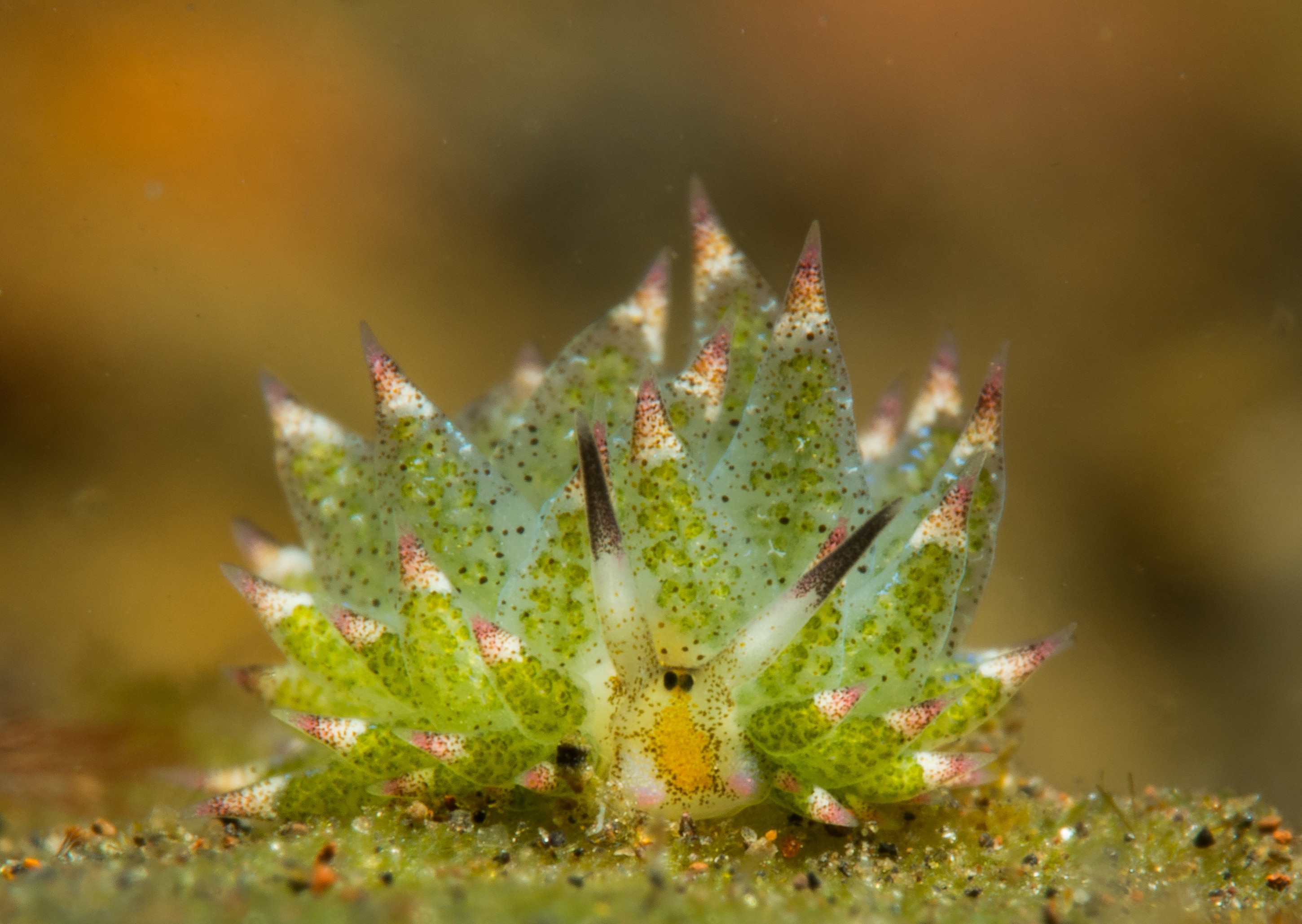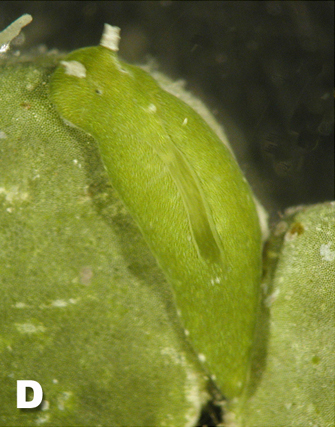Kleptoplast on:
[Wikipedia]
[Google]
[Amazon]
 Kleptoplasty or kleptoplastidy is a
Kleptoplasty or kleptoplastidy is a
 '' Mesodinium rubrum'' is a
'' Mesodinium rubrum'' is a

 Some of the only known animals that practice kleptoplasty are
Some of the only known animals that practice kleptoplasty are  Due to this unusual ability, the sacoglossans are sometimes referred to a "solar-powered sea slugs," though the actual benefit from photosynthesis on the survival of some of the species that have been analyzed seems to be marginal at best. In fact, some species may even die in the presence of the carbon dioxide-fixing kleptoplasts as a result of elevated levels of reactive oxygen species.
Changes in temperature have been shown to negatively affect kleptoplastic abilities in sacoglossans. Rates of photosynthetic efficiency as well as kleptoplast abundance have been shown to decrease in correlation to a decrease in temperature. The patterns and rate of these changes, however, varies between different species of sea slug.
Due to this unusual ability, the sacoglossans are sometimes referred to a "solar-powered sea slugs," though the actual benefit from photosynthesis on the survival of some of the species that have been analyzed seems to be marginal at best. In fact, some species may even die in the presence of the carbon dioxide-fixing kleptoplasts as a result of elevated levels of reactive oxygen species.
Changes in temperature have been shown to negatively affect kleptoplastic abilities in sacoglossans. Rates of photosynthetic efficiency as well as kleptoplast abundance have been shown to decrease in correlation to a decrease in temperature. The patterns and rate of these changes, however, varies between different species of sea slug.
 Kleptoplasty or kleptoplastidy is a
Kleptoplasty or kleptoplastidy is a symbiotic
Symbiosis (from Greek , , "living together", from , , "together", and , bíōsis, "living") is any type of a close and long-term biological interaction between two different biological organisms, be it mutualistic, commensalistic, or para ...
phenomenon whereby plastid
The plastid (Greek: πλαστός; plastós: formed, molded – plural plastids) is a membrane-bound organelle found in the cells of plants, algae, and some other eukaryotic organisms. They are considered to be intracellular endosymbiotic cyan ...
s, notably chloroplast
A chloroplast () is a type of membrane-bound organelle known as a plastid that conducts photosynthesis mostly in plant and algal cells. The photosynthetic pigment chlorophyll captures the energy from sunlight, converts it, and stores it i ...
s from algae
Algae (; singular alga ) is an informal term for a large and diverse group of photosynthetic eukaryotic organisms. It is a polyphyletic grouping that includes species from multiple distinct clades. Included organisms range from unicellular micr ...
, are sequestered by host organisms. The word is derived from ''Kleptes'' (κλέπτης) which is Greek
Greek may refer to:
Greece
Anything of, from, or related to Greece, a country in Southern Europe:
*Greeks, an ethnic group.
*Greek language, a branch of the Indo-European language family.
**Proto-Greek language, the assumed last common ancestor ...
for thief
Theft is the act of taking another person's property or services without that person's permission or consent with the intent to deprive the rightful owner of it. The word ''theft'' is also used as a synonym or informal shorthand term for some ...
. The alga is eaten normally and partially digested, leaving the plastid intact. The plastids are maintained within the host, temporarily continuing photosynthesis
Photosynthesis is a process used by plants and other organisms to convert light energy into chemical energy that, through cellular respiration, can later be released to fuel the organism's activities. Some of this chemical energy is stored in ...
and benefiting the predator. The term was coined in 1990 to describe chloroplast symbiosis.
Ciliates
 '' Mesodinium rubrum'' is a
'' Mesodinium rubrum'' is a ciliate
The ciliates are a group of alveolates characterized by the presence of hair-like organelles called cilia, which are identical in structure to eukaryotic flagella, but are in general shorter and present in much larger numbers, with a differen ...
that steals chloroplasts from the cryptomonad
The cryptomonads (or cryptophytes) are a group of algae, most of which have plastids. They are common in freshwater, and also occur in marine and brackish habitats. Each cell is around 10–50 μm in size and flattened in shape, with an anteri ...
''Geminigera cryophila
''Geminigera'' /ˌdʒɛmɪnɪˈdʒɛɹə/ is a genus of cryptophyte from the family Geminigeraceae. Named for its unique pyrenoid
Pyrenoids are sub-cellular micro-compartments found in chloroplasts of many algae,Giordano, M., Beardall, J., ...
''. ''M. rubrum'' participates in additional endosymbiosis by transferring its plastids to its predators, the dinoflagellate planktons belonging to the genus ''Dinophysis''.
Karyoklepty is a related process in which the nucleus of the prey cell is kept by the predator as well. This was first described in 2007 in ''M. rubrum''.
Dinoflagellates
The stability of transient plastids varies considerably across plastid-retaining species. In thedinoflagellate
The dinoflagellates ( Greek δῖνος ''dinos'' "whirling" and Latin ''flagellum'' "whip, scourge") are a monophyletic group of single-celled eukaryotes constituting the phylum Dinoflagellata and are usually considered algae. Dinoflagellates are ...
s ''Gymnodinium'' spp. and '' Pfisteria piscicida'', kleptoplastids are photosynthetically active for only a few days, while kleptoplastids in ''Dinophysis'' spp. can be stable for 2 months. In other dinoflagellates, kleptoplasty has been hypothesized to represent either a mechanism permitting functional flexibility, or perhaps an early evolution
Evolution is change in the heritable characteristics of biological populations over successive generations. These characteristics are the expressions of genes, which are passed on from parent to offspring during reproduction. Variation ...
ary stage in the permanent acquisition of chloroplasts.
Sacoglossan sea slugs

 Some of the only known animals that practice kleptoplasty are
Some of the only known animals that practice kleptoplasty are sea slug
Sea slug is a common name for some marine invertebrates with varying levels of resemblance to terrestrial slugs. Most creatures known as sea slugs are gastropods, i.e. they are sea snails (marine gastropod mollusks) that over evolutionary tim ...
s in the clade Sacoglossa
Sacoglossa, commonly known as the sacoglossans or the "solar-powered sea slugs", are a superorder of small sea slugs and sea snails, marine gastropod mollusks that belong to the clade Heterobranchia. Sacoglossans live by ingesting the cellular co ...
. Several species of Sacoglossan sea slugs capture intact, functional chloroplasts from algal food sources, retaining them within specialized cells lining the mollusc
Mollusca is the second-largest phylum of invertebrate animals after the Arthropoda, the members of which are known as molluscs or mollusks (). Around 85,000 extant species of molluscs are recognized. The number of fossil species is est ...
's digestive diverticula
In medicine or biology, a diverticulum is an outpouching of a hollow (or a fluid-filled) structure in the body. Depending upon which layers of the structure are involved, diverticula are described as being either true or false.
In medicine, t ...
. The longest known kleptoplastic association, which can last up to ten months, is found in '' Elysia chlorotica'', which acquires chloroplasts by eating the alga ''Vaucheria litorea
''Vaucheria litorea'' is a species of yellow-green algae (Xanthophyceae). It grows in a filamentous fashion (forming long tubular cells connected end to end). ''V. litorea'' is a common intertidal species of coastal brackish waters and salt mars ...
'', storing the chloroplasts in the cells that line its gut. Juvenile sea slugs establish the kleptoplastic endosymbiosis when feeding on algal cells, sucking out the cell contents, and discarding everything except the chloroplasts. The chloroplasts are phagocytosed
Phagocytosis () is the process by which a cell uses its plasma membrane to engulf a large particle (≥ 0.5 μm), giving rise to an internal compartment called the phagosome. It is one type of endocytosis. A cell that performs phagocytosis is c ...
by digestive cells, filling extensively branched digestive tubules, providing their host with the products of photosynthesis. It is not resolved, however, whether the stolen plastids actively secrete photosynthate or whether the slugs profit indirectly from slowly degrading kleptoplasts.
 Due to this unusual ability, the sacoglossans are sometimes referred to a "solar-powered sea slugs," though the actual benefit from photosynthesis on the survival of some of the species that have been analyzed seems to be marginal at best. In fact, some species may even die in the presence of the carbon dioxide-fixing kleptoplasts as a result of elevated levels of reactive oxygen species.
Changes in temperature have been shown to negatively affect kleptoplastic abilities in sacoglossans. Rates of photosynthetic efficiency as well as kleptoplast abundance have been shown to decrease in correlation to a decrease in temperature. The patterns and rate of these changes, however, varies between different species of sea slug.
Due to this unusual ability, the sacoglossans are sometimes referred to a "solar-powered sea slugs," though the actual benefit from photosynthesis on the survival of some of the species that have been analyzed seems to be marginal at best. In fact, some species may even die in the presence of the carbon dioxide-fixing kleptoplasts as a result of elevated levels of reactive oxygen species.
Changes in temperature have been shown to negatively affect kleptoplastic abilities in sacoglossans. Rates of photosynthetic efficiency as well as kleptoplast abundance have been shown to decrease in correlation to a decrease in temperature. The patterns and rate of these changes, however, varies between different species of sea slug.
Nudibranchs
Some species of nudibranchs such as ''Pteraeolidia ianthina'' sequester whole living symbiotic zooxanthellae within their digestive diverticula, and thus are also "solar-powered".Foraminifera
Some species of the foraminiferan genera ''Bulimina'', ''Elphidium'', ''Haynesina'', ''Nonion'', ''Nonionella'', ''Nonionellina'', ''Reophax'', and ''Stainforthia'' have been shown to sequester diatom chloroplasts.Rhabdocoel flatworms
Two species from the group of marine flatworms known as the Rhabdocoela, rhabdocoels, ''Baicalellia solaris'' and ''Pogaina paranygulgus,'' have been found to constitute another type of animal that displays kleptoplasty. The group was previously classified as having algal endosymbionts, though it was already discovered that the endosymbionts did not contain nuclei. While consuming diatoms, ''B. solaris'' and ''P. paranygulus'', in a process not yet discovered, extract plastids from their prey, incorporating them subepidermally, while separating and digesting the frustule and remainder of the diatom. In ''B. solaris'' the extracted plastids, or kleptoplasts, continue to exhibit functional photosynthesis for a short period of roughly 7 days. As the two groups are not sister taxa, and the trait is not shared among groups more closely related, there is evidence that kleptoplasty evolved independently within the two taxa.See also
*Horizontal gene transfer *KleptoproteinReferences
External links
*{{cite web , url=http://www.abc.net.au/science/scribblygum/june2007/#a , title=Solar Powered Sea Slugs , date=June 2007 , publisher=ABC Science Online, access-date=2008-11-24 Algae Ecology terminology Endosymbiotic events